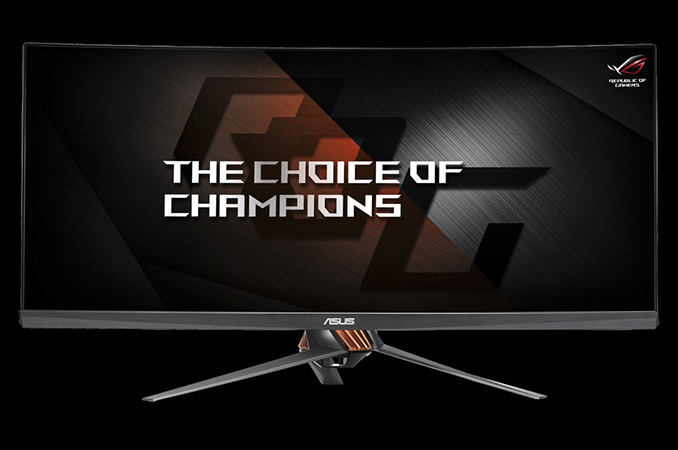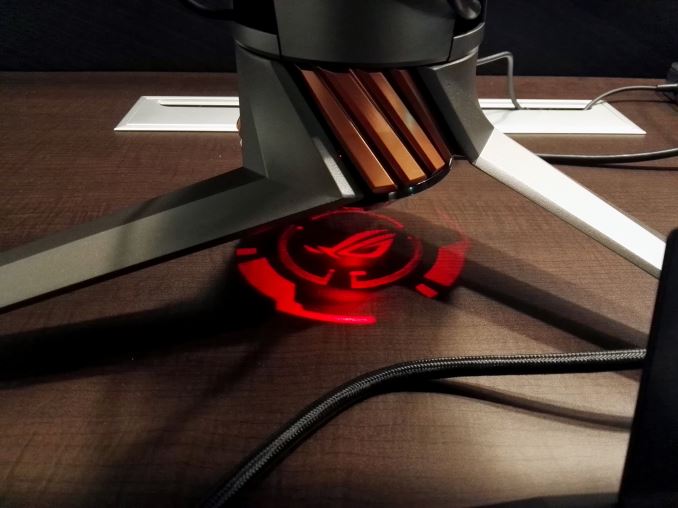ASUS Starts to Ship Its First Curved Ultra-Wide Display: ROG Swift PG348Q
by Anton Shilov on March 17, 2016 6:00 PM EST
ASUS this week began to ship its first gaming curved ultra-wide display, the ROG Swift PG348Q, which the company introduced back in September and showcased at CES. The monitor, which is the largest ROG display ever, is designed primarily for gamers, features up to 100 Hz refresh rate as well as Nvidia’s G-Sync technology.
The ASUS ROG Swift PG348Q display is based on an IPS panel with 3440×1440 resolution, 1000:1 contrast ratio and 300 cd/m2 brightness. The ultra-wide 34” monitor features 21:9 aspect ratio and 3800R screen curvature, which is larger than a number of 3000R panels that are currently on the market. The monitor can reproduce 1.07 billion colors and covers 100% of sRGB color space, which is not a bad result for a gaming solution. The ROG Swift PG348Q has default refresh rate of 60 Hz and everything between that and 100 Hz should be activated using a special turbo button. ASUS claims that G-Sync variable refresh-rate technology on this display actually works at up to 100 Hz, but to ensure high framerate (as well as refresh rate), a graphics card with sufficient processing performance (e.g., GeForce GTX 980 Ti and higher) is required with demanding titles.
| Specifications of ASUS' Curved Display | |||
| ASUS ROG Swift PG348Q | |||
| Panel | 34" IPS | ||
| Resolution | 3440 x 1440 | ||
| Refresh Rate | 50 Hz - 100 Hz | ||
| Response Time | 5 ms gray-to-gray | ||
| Brightness | 300 cd/m² | ||
| Contrast | 1000:1 | ||
| Viewing Angles | 178°/178° horizontal/vertical | ||
| PPI | 109 pixels per inch | ||
| Colors | 1.07 billion | ||
| Color Saturation | 100% sRGB | ||
| Curvature | 3800R | ||
The ROG Swift PG348Q is equipped with one DisplayPort 1.2 and one HDMI 1.4 inputs. The latter only supports 3440×1440 resolution with 50 Hz refresh rate, according to ASUS; for everything between 50 Hz and 100 Hz the DP input must be used. The display also features a 4-port USB 3.0 hub and two 2 W speakers.
The ROG Swift PG348Q will be ASUS’s largest display ever. It will also be the company’s flagship monitor for gamers for a while. Since the company does not offer non-curved gaming displays larger than 28”, one might expect to expect ASUS to introduce one or two non-gaming models in the future.
The new display uses the new ASUS ROG color scheme — plasma copper inlays on armor titanium casing as well as an LED effect on the bottom. The monitor also has an ultra-thin frame (which ASUS calls frameless design) as well as tilt, swivel, and height adjustments. Eventually, other ROG-branded displays will inherit similar design and color scheme.
ASUS did not reveal the official MSRP of its ROG Swift PG348Q display and at time to press, and the product should be available at major U.S. retail stores from May. Given the fact that the monitor is a pretty unique combination consisting of a curved IPS panel, high resolution, G-Sync technology and up to 100 Hz refresh rate, this product will be in the upper echelons of monitor pricing. TechReport caught the fact that this panel is being offered by iBuyPower as an add-on option to a prebuilt system for $1200, so we would expect the full retail price to be in that $900-$1200 region. Anyone still want VR?
Source: ASUS

















31 Comments
View All Comments
joos2000 - Friday, March 18, 2016 - link
It's interesting that the higher number for the radii is marked as a feature, since the higher the radii the flatter the screen is. Which in essence means that this monitor is less gimmicky than the competition.If you really want each pixel of the screen to be equidistant from the users eye, the radii of the screens curvature should be about an arms length, ie less than 1000 mm.
MrSpadge - Friday, March 18, 2016 - link
Well, if you sit 3.8 m away from the screen the apparent pixel density will beat regular 4k screens and you can see the entire contents of the screen at one glance, i.e. it's not too big ;)Solandri - Friday, March 18, 2016 - link
At this point, I'm pretty sure the curve is to reduce flexing of the screen causing warping of the diffusers, not to make the pixels equidistant from the eyes. I see the temporary uneven lighting this warping causes every time I grab my laptop lid by the corner to close it, and I wonder if it's going to cause long-term damage. Yes a monitor is not handled as much, but the problem is compounded by having a larger screen size.xenol - Friday, March 18, 2016 - link
One of the things I noticed with another 34" ultrawide monitor was that the LCD itself appeared to "float" from where my mind thought it should be. That is, if I looked at the edge, part of the image would be more or less unviewable because the backlight from that angle wasn't shining under it.AndrewJacksonZA - Friday, March 18, 2016 - link
Is there going to be a FreeSync version?R3MF - Friday, March 18, 2016 - link
"The ultra-wide 34” monitor features 21:9 aspect ratio and 3800R screen curvature, which is larger than a number of 3000R panels that are currently on the market."When you say "larger", would it make sense to your readership to say "less curved"?
Smaller the radius, tighter the curve.
Solandri - Friday, March 18, 2016 - link
In engineering and manufacturing, curvature is defined by the radius of curvature. Not by the "tightness" of the curve.asmian - Friday, March 18, 2016 - link
End-users are unlikely to be engineers or involved in manufacturing design to understand such a pernickety definition. THEY are who the review is for. Therefore a common-sense ("clear English") use of language should prevail. I also read (perhaps you would argue misread) "larger" curvature as being a MORE curved screen - "larger" is a common synonym for "greater". Use of unclear language is therefore disseminating misinformation in this situation, however technically "correct" you can argue it is if you happen to be one of the few people aware of that proper usage.Murloc - Sunday, March 20, 2016 - link
I agree that it's not immediately clear until you look at the numbers.T1beriu - Friday, March 18, 2016 - link
Please ASUS, make a Freesync version! :)